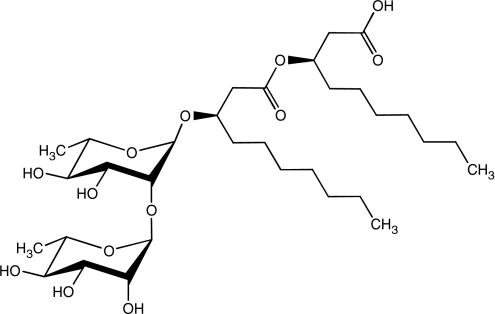Application of Rhamnolipid
Apr 21,2022
Rhamnolipid is known as a biosurfactant and is secreted from the bacterium - pseudomonas aeruginosa. Surfactants are soaps made from petroleum. Biosurfactants are soaps made without petroleum and are ubiquitous. They are found indoors and outdoors. They can be found on tabletops, clothes, trees and animals.

Produce
Rhamnolipids (RL) are surface-active glycolipids produced by Pseudomonas aeruginosa. They are always produced by this bacterium as a complex mixture of congeners, each composed of one or two rhamnose molecules linked to a dimer of 3-hydroxyfatty acids with a chain length of 8–12 carbons.
Application
Rhamnolipid (with rhamnolipid being both singular and plural i.e. fish) have widespread application and their utility across several diverse industries (pharmaceutical, cosmetics, food, environmental clean-up, agriculture, water treatment, oil and heavy petroleum recovery (enhanced oil recovery) and soil washing) is being recognized world wide as a non-toxic, biodegradable environmentally safe application. Although, rhamnolipid have been studied for more than sixty years (discovered in 1949), interest in rhamnolipids has increased since the 1990’s as the search for more ecological responsible products intensified.
Commercial potential of rhamnolipids
Surfactants are in demand for a wide range of industrial applications as they increase solubility, foaming capacity and lower surface tensions. In particular, rhamnolipids have been used broadly in the cosmetic industry for products such as moisturisers, condom lubricant and shampoo.Rhamnolipids are efficacious in bioremediation of organic and heavy metal polluted sites.They also facilitate degradation of waste hydrocarbons such as crude oil and vegetable oil by Pseudomonas aeruginosa.The rhamnolipid surfactant itself is valuable in the cosmetic industry, and rhamnolipids are a source of rhamnose, which is an expensive sugar in itself.
Other bio-based surfactants include sophorolipids and mannose-erythritol lipids.
- Related articles
- Related Qustion
- Biosynthesis of Rhamnolipids Feb 15, 2022
Rhamnolipids are a class of glycolipid produced by Pseudomonas aeruginosa, amongst other organisms, frequently cited as bacterial surfactants.They have a glycosyl head group, in this case a rhamnose moiety, and a 3-(hydroxyalkanoyloxy)alkan
Hydrogen fluoride is a colorless, corrosive liquid or gas and is composed of a hydrogen atom and a fluorine atom.....
Apr 20,2022Inorganic chemistryHexapeptide-11 is a bio fermented peptide that has been shown in studies, run on human dermal fibroblasts, to upregulate key genes responsible for collagen production and important extracellular matrix components such as hyaluronic acid.....
Apr 21,2022Biochemical Engineeringrhamnolipid
869062-42-0You may like
- Acid phosphatases and Phosphatase, Acid from wheat germ
May 27, 2024
- The structure and Biological function of Cytochrome C
May 17, 2024
- Is CJC-1295 DAC same as CJC-1295?
May 16, 2024





